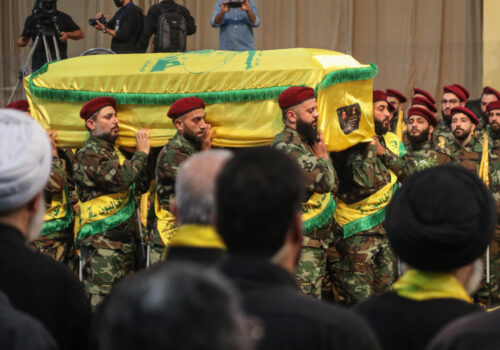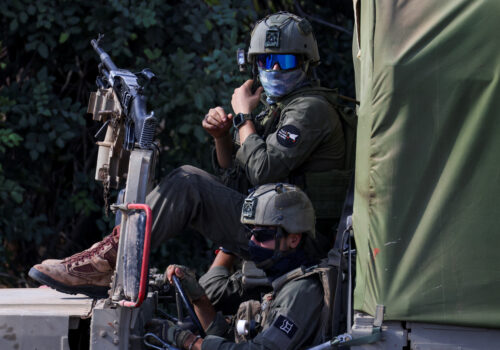The Israeli offensive and Iranian missile attack test two visions for the Middle East’s future
The coming months will determine whether Israel’s stunning offensive against Hezbollah over the past month, which has now triggered an Iranian ballistic missile attack on Israel, perpetuates and escalates the relentless cycle of Middle East violence or marks a positive tipping point against Iranian-backed aggression.
Israel’s killing of Hezbollah leader Hassan Nasrallah—made possible by rock-solid intelligence and a lethal payload of as many as eighty bombs that penetrated his Beirut bunker—has escalated a collision course between two dramatically different visions of the Middle East’s future.
One is driven by Iran and its proxies, including Hezbollah in Lebanon, the Houthis in Yemen, and Hamas in Gaza. It’s characterized by the continuation of violent conflict, and its goal is the destruction of Israel and the triumph of a radical, extremist, and revolutionary form of Islam.
The second course finally seizes the initiative to counter and contain Iran’s ambitions, disrupts and degrades its proxies’ military potential, and lays the groundwork for the eventual emergence of a dynamic, peaceful, modernizing Middle East.
This vision foresees a more integrated region over time, with new economic and security arrangements built off of the Abraham Accords. Most importantly, it would include Israeli-Saudi normalization and a path certain toward Palestinian statehood.
Taking the long view
This more positive track might seem an impossible dream, given the real and immediate threats of a wider war. On Monday, Israel announced the start of a “limited” ground operation in Lebanon. Then today, Iran struck Israel with what the Israel Defense Forces said was 180 missiles, many of which were intercepted. More escalation could be on the way in the near term. It’s important, however, not to lose sight of this historic upside potential as Israel, Iran, Iran’s proxies, and other regional and outside actors weigh their next moves.
It’s crucial to recall that Europe only built its more positive path after centuries of conflict and on the rubble of two world wars. With Russia’s ongoing war against Ukrainian freedom and independence, Europe’s story of peaceful integration is far from over, but it has advanced far beyond Cold War-era expectations.
It was only through a patient, consistent approach by the United States and its allies to contain and counter the Soviet Union that Western Europe was able to deter Moscow militarily and eventually expand its community of peace and prosperity. It took more than forty years of effort to achieve Cold War triumph.
The approach now toward Iran should take inspiration from that model, countering, deterring, and isolating Tehran so that, over time, the Iranian people will demand change in the face of the growing attraction of the economic, societal, and political successes of the wider Middle East.
It would be premature to declare the death of Nasrallah as the tipping point toward this future. It would be short-sighted, however, not to see this moment as an opportunity to be seized in the struggle against the regional ambitions of Iran and its proxies.
What makes the stakes even larger is the global context of Iran’s increased common cause with Russia, China, and North Korea. Together they seek to undermine the global order that the United States and its partners so painstakingly constructed after World War II. Iran’s new deliveries of short-range ballistic missiles and ongoing supply of armed drones to Russia for its war on Ukraine underscore the global stakes involved.
Reasons for hope
Amid all the present escalation, several factors provide longer-term hope.
First is the seminal importance of Nasrallah’s death to disrupting Iran’s decades-old use of proxies against its enemies.
“In his 32 years at the helm of Hizbollah,” Financial Times reporter Raya Jalabi wrote in Nasrallah’s obituary, “the 64-year-old cleric was credited with making it the pre-eminent force in Iran’s regional network of proxies known as the axis of resistance.”
After the US assassination of Iranian General Qassem Soleimani in 2020, Nasrallah was second in importance in that axis only to Iran’s supreme leader, Ayatollah Ali Khamenei. In nearly four decades of Israel battling Hezbollah with limited success, as it continued to build its arsenal as the point edge of Iran’s proxy spear, his death marks the best opportunity yet to turn the tide on Iran.
Second is Iran’s economic fragility and its instinct for self-preservation.
The Atlantic Council’s Jonathan Panikoff explains that Iran is split internally about how hard to respond to Israel. The Islamic Revolutionary Guard Corps, the multiservice branch of Iran’s armed services, and other hard-liners are likely advocating for a more aggressive response to restore deterrence and shore up Hezbollah. They are almost certainly the factions that pushed for today’s ballistic missile strike on Israel.
However, Masoud Pezeshkian, Iran’s reformist president who took office in July, has spoken of Israel’s escalation as “a trap” to draw Tehran into a wider war that it cannot win. Avoiding direct conflict with Israel is crucial to Iran’s desire to repair its ailing economy and ease Western sanctions against it.
Israel has put Iran in a no-win situation. If it fails to escalate and strike Israel, it loses credibility with its proxies, which believe it hasn’t done enough to help them. Yet escalation could result in retaliatory strikes from Israel on Iran itself, up to and including its nuclear facilities.
Today’s strike looks like something of a compromise, enough of an attack to assuage hard-liners and buy Iran’s leadership time without going so far as to trigger a wider war with Israel or, even worse, with the United States.
Importantly, Israel’s recent actions have restored the aura of its intelligence capability and strengthened its ability to deter its enemies. Both had been called into question following Hamas’s terrorist attack on October 7, 2023, which left 1,200 dead in Israel and triggered a conflict that has now resulted in an estimated 40,000 dead in Gaza.
It has been the remarkable quality and depth of Israeli intelligence, and probably also its vast mining of data, that has allowed its change of course with Hezbollah. Accurate and precise intelligence is what allowed Israel to take out Fuad Shukr, one of Nasrallah’s most crucial lieutenants, in late July and to sabotage thousands of pagers and walkie-talkies in September. It was necessary to pinpoint the location of Nasrallah and it will be valuable in planning its ground operations in Lebanon.
Significantly as well, the countries that signed the Abraham Accords with Israel haven’t abandoned hope of returning to the course of normalization, which will be crucial if Israel is to turn the tide on what has become the most existential threat to the Jewish state since the 1973 Yom Kippur War.
None has cut off relations with Israel, nor disassociated themselves from the accords. And while many, including the United Arab Emirates, have sought to calm tensions with Iran, they do so with eyes wide open on the continuing threat Iran represents and with the steadfast belief that over the long term, Israel will be more integrated into the Middle East, not less as Iran desires. What they don’t yet share is an agreed-upon pathway to achieve that, and they have vehemently opposed Israel’s approach to Gaza and beyond.
It’s a far distance from where we are today to a new order for the Middle East. It’s that vision, however, that should animate responses to the current crisis, turning gathering threats into historic opportunity.
Frederick Kempe is president and chief executive officer of the Atlantic Council. You can follow him on X: @FredKempe.
This edition is part of Frederick Kempe’s Inflection Points newsletter, a column of dispatches from a world in transition. To receive this newsletter throughout the week, sign up here.
Further reading
Sun, Sep 29, 2024
After Nasrallah, three quandaries shape the future of the war—and the Middle East
New Atlanticist By Jonathan Panikoff
Hassan Nasrallah’s death creates interrelated quandaries for Hezbollah, Iran, and Israel that will determine if the region erupts in conflict and shape what it looks like for years to come.
Sat, Sep 28, 2024
Hezbollah is diminished, decapitated, and in disarray—but still dangerous
New Atlanticist By William F. Wechsler
The death of Hassan Nasrallah leaves Hezbollah weakened, but as Israel’s history with the Iran-backed group demonstrates, decapitation operations are often necessary to win the battle but always far from sufficient to win the peace.
Tue, Oct 1, 2024
Four questions (and expert answers) about Israel’s ground operation in Lebanon
New Atlanticist By Shalom Lipner
Shalom Lipner, a former advisor to seven consecutive Israeli prime ministers, answers the burning questions about Israel’s strategy and what the US should do.
Image: Iranians celebrate on a street, after the IRGC attack on Israel, in Tehran, Iran, October 1, 2024. Majid Asgaripour/WANA



